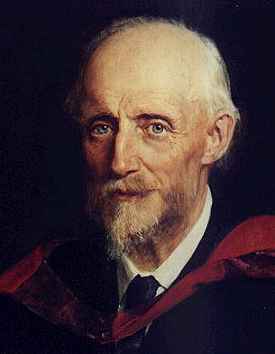Osborne Reynolds (1842-1912)
 Osborne
was born in Belfast where his father was Principal of the Collegiate School
there but began his schooling at Dedham when his father was headmaster of the
school in that Essex town. After that he received private tutoring to complete
his secondary education. He did not go straight to university after his secondary
education, however, but rather he took an apprenticeship with the engineering
firm of Edward Hayes in 1861. Reynolds, after gaining experience in the engineering
firm, studied mathematics at Cambridge, graduating in 1867. As an undergraduate
Reynolds had attended some of the same classes as Rayleigh who was one year
ahead of him.
Osborne
was born in Belfast where his father was Principal of the Collegiate School
there but began his schooling at Dedham when his father was headmaster of the
school in that Essex town. After that he received private tutoring to complete
his secondary education. He did not go straight to university after his secondary
education, however, but rather he took an apprenticeship with the engineering
firm of Edward Hayes in 1861. Reynolds, after gaining experience in the engineering
firm, studied mathematics at Cambridge, graduating in 1867. As an undergraduate
Reynolds had attended some of the same classes as Rayleigh who was one year
ahead of him.
As his father had before him, Reynolds was elected to a scholarship at Queens' College. He again took up a post with an engineering firm, this time the civil engineers John Lawson of London, spending a year as a practicing civil engineer. In 1868 Reynolds became the first professor of engineering in Manchester (and the second in England).
Reynolds held this post until he retired in 1905. His early work was on magnetism and electricity but he soon concentrated on hydraulics and hydrodynamics. He also worked on electromagnetic properties of the sun and of comets, and considered tidal motions in rivers. After 1873 Reynolds concentrated mainly on fluid dynamics and it was in this area that his contributions were of world leading importance. He studied the change in a flow along a pipe when it goes from laminar flow to turbulent flow. In 1886 he formulated a theory of lubrication. Three years later he produced an important theoretical model for turbulent flow and it has become the standard mathematical framework used in the study of turbulence.
His studies of condensation and heat transfer between solids and fluids brought radical revision in boiler and condenser , while his work on turbine pumps permitted their rapid development. A paper published in 1883 entitled "An experimental investigation of the circumstances which determine whether the motion of water in parallel channels shall be direct or sinuous and of the law of resistance in parallel channels" introduced what is now known as the 'Reynolds number', a variable commonly used in modeling fluid flow. Reynolds became a Fellow of the Royal Society in 1877 and, 11 years later, won their Royal Medal. In 1884 he was awarded an honorary degree by the University of Glasgow. By the beginning of the 1900s Reynolds health began to fail and he retired in 1905. Not only did he deteriorate physically but also mentally, which was sad to see in so brilliant a man who was hardly 60 years old.
... Despite his intense interest in education, he was not a great lecturer. His lectures were difficult to follow, and he frequently wandered among topics with little or no connection. Lamb, who knew Reynolds well both as a man and as a fellow worker in fluid dynamics, wrote:- The character of Reynolds was like his writings, strongly individual. He was conscious of the value of his work, but was content to leave it to the mature judgment of the scientific world. For advertisement he had no taste, and undue pretension on the part of others only elicited a tolerant smile. To his pupils he was most generous in the opportunities for valuable work which he put in their way, and in the share of cooperation.

Connect with us
Contact us today